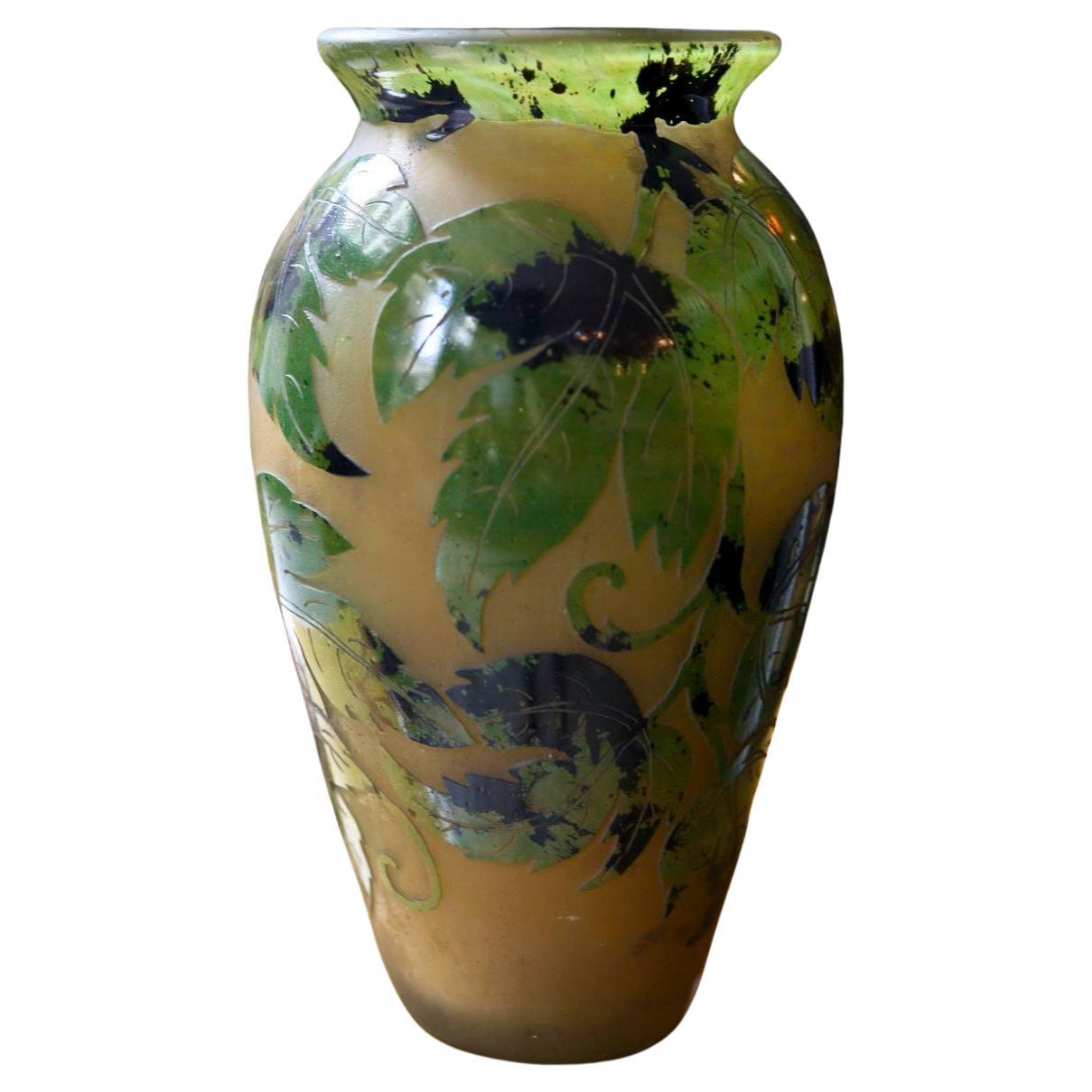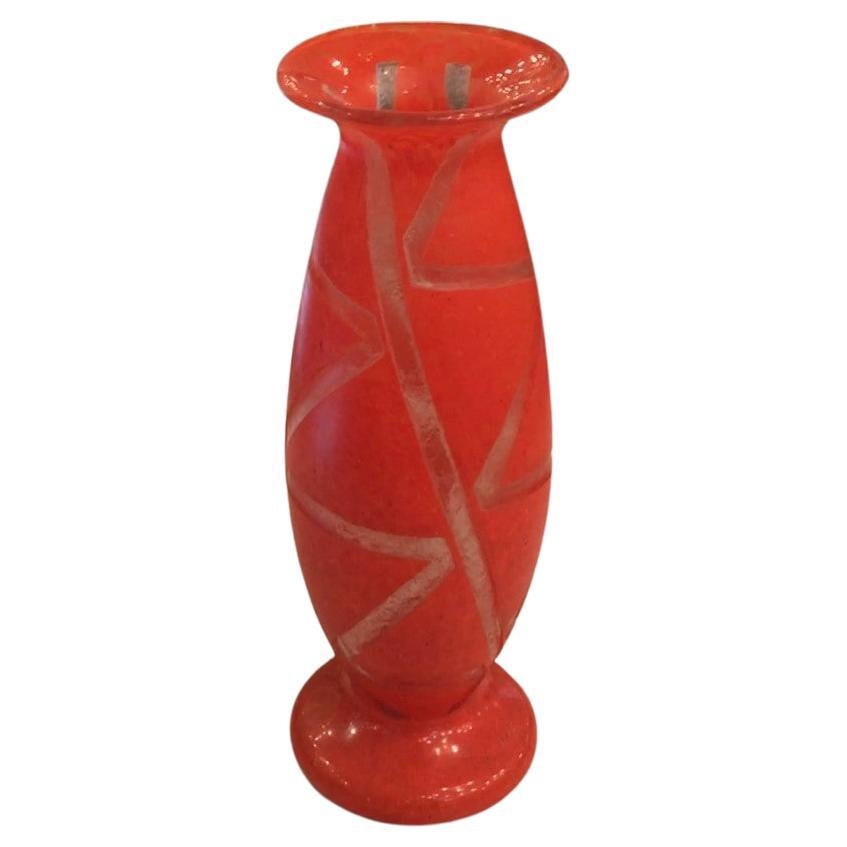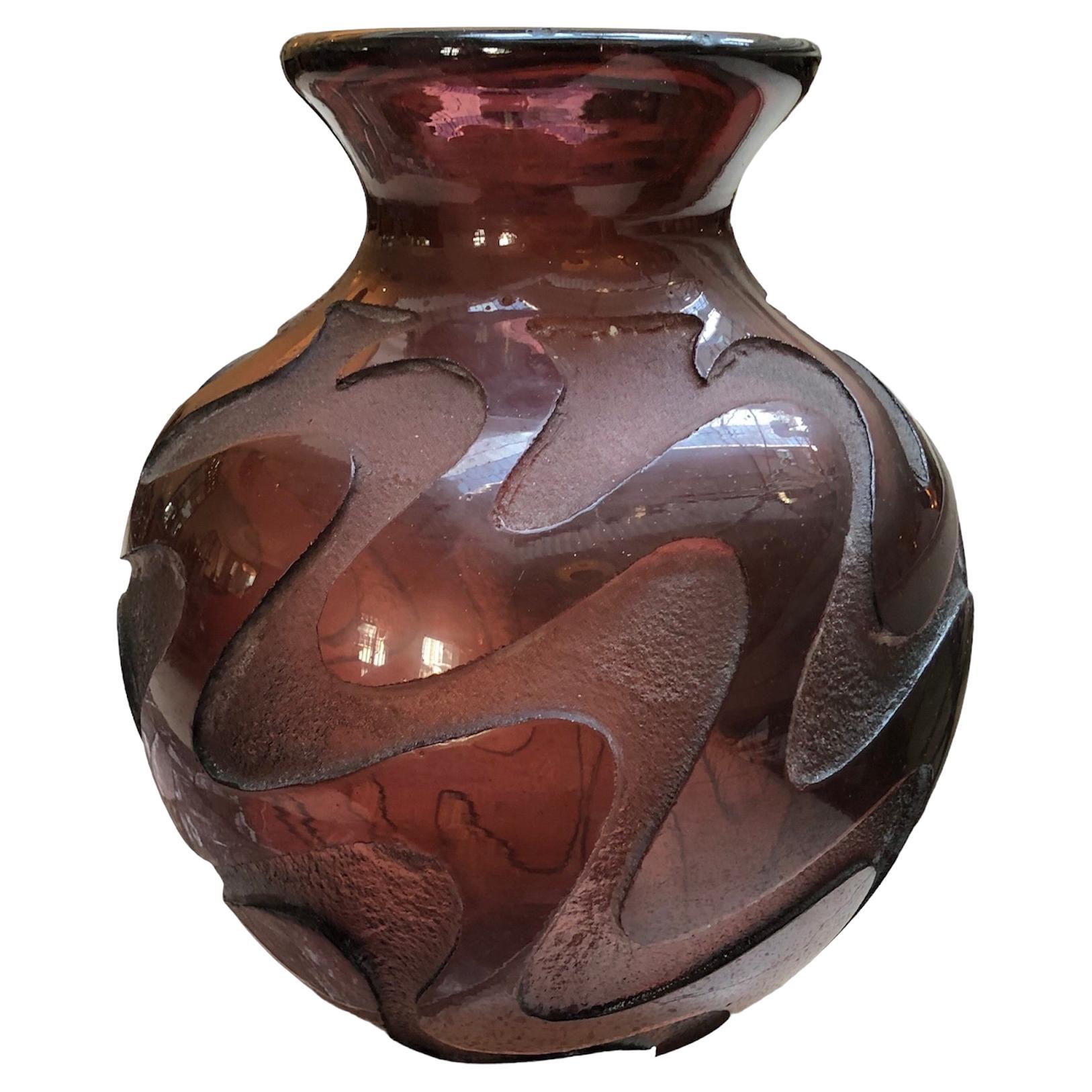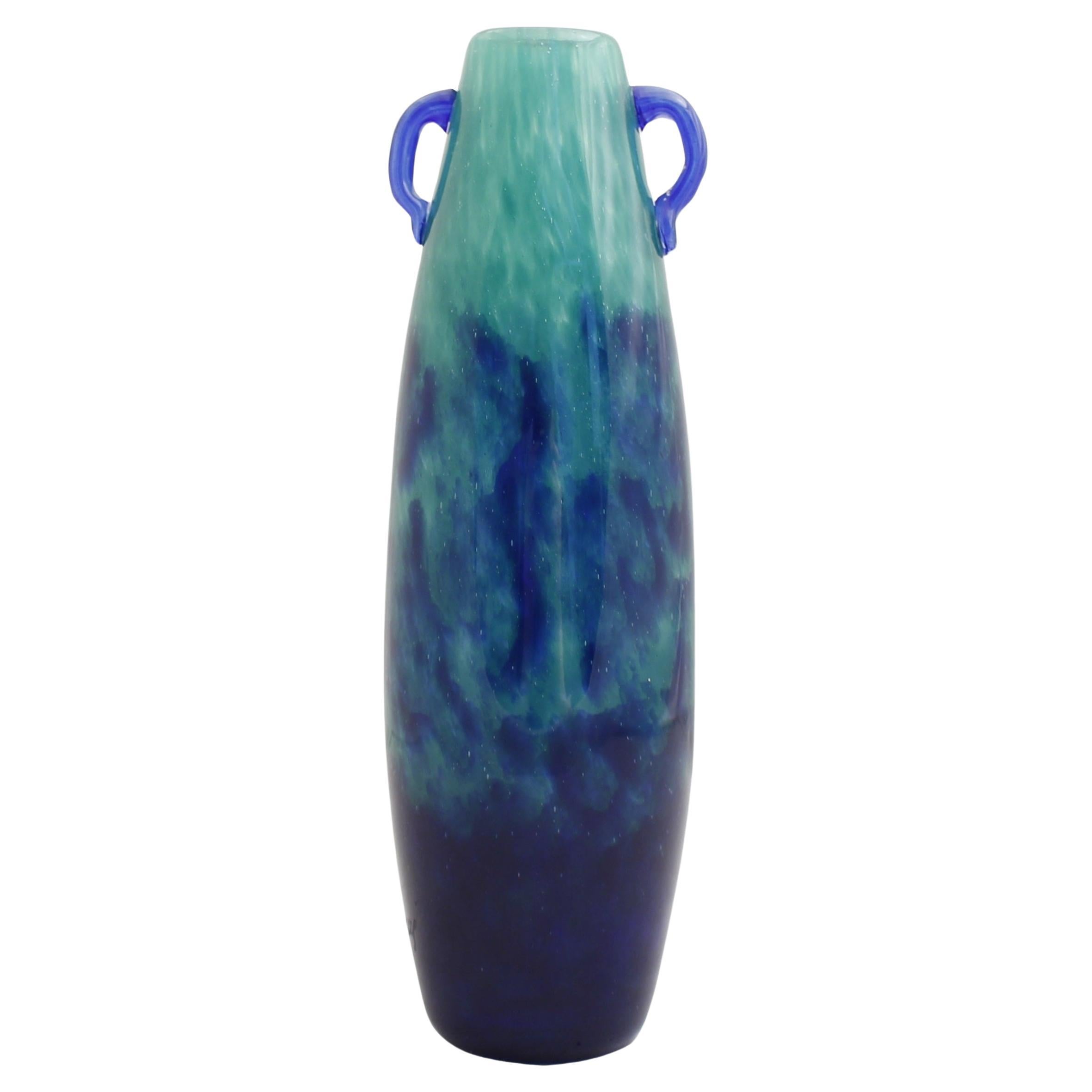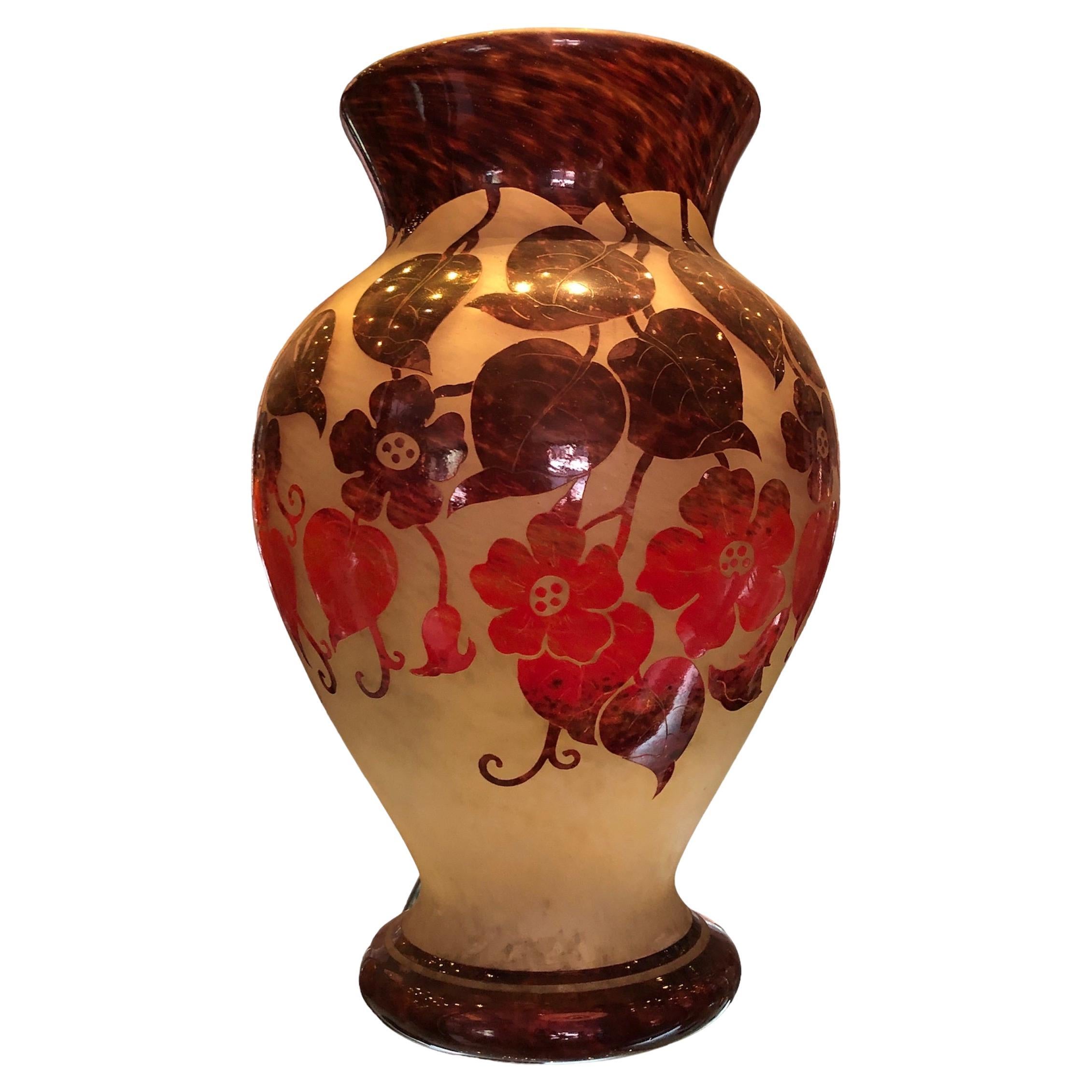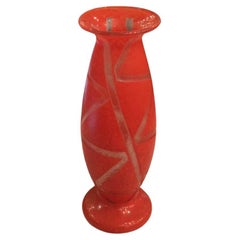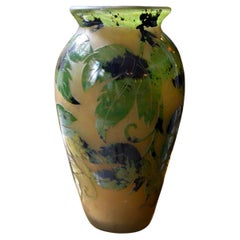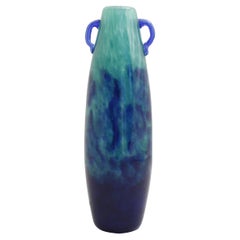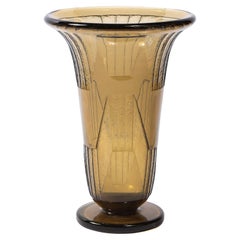Items Similar to Vase Sign: Degué, 1926, Style: Art Deco
Video Loading
Want more images or videos?
Request additional images or videos from the seller
1 of 22
Vase Sign: Degué, 1926, Style: Art Deco
About the Item
Degue : David Guéron design Edouard Cazaux
David Gueron, Turkish and a former fighter of the French Foreign Legion, was the founder of the "Cristalleries De Compiegne". This glassworks mainly produced household glass in the early '20. David Gueron soon discovered that he wanted more with his capacities in the glass industry. In 1926 he founded a new factory, which he called "Verrerie D'Art Degue" and put his full attention on the designing and production of Art Deco luxury art-glass. His factory was at "Boulevard Malesherbes" and his showroom at the "41 rue de Paris". Gueron mainly produced vases, lamps and chandeliers. His glass got well known because of it's full and deep colors, which he achieved with a special process (especially red, orange, yellow and green). Gueron was also guilty of copying designs of other successful French glass artists like Daum, Galle, Muller Freres and Schneider. One can see imitation as the highest form of flattery, but Schneider thought else wise and sued Degue, who not only imitated, but also managed to take on several glassworkers of Schneider as well. Schneider eventually won the lawsuit, but the lengthily law process (1926-1932), cost both firms a lot of money and they both almost had to close their factories. When the Second World War started David Gueron shut his glassworks. He fled France and was lat seen in Paris in 1949. His factory in Compiegne still stands and is nowadays owned by a company selling tiles and doorframes. The old furnace downstairs still has glass melted to its walls.
We have specialized in the sale of Art Deco and Art Nouveau styles since 1982.If you have any questions we are at your disposal.
Pushing the button that reads 'View All From Seller'. And you can see more objects to the style for sale.
Why are there so many antiques in Argentina?
In the 1880 – 1940 there was a grate wave of immigration encouraged by the periods of war that were taking place.
1st World War took place between 1914 and 1918
2nd World War took place between 1939 and 1945
The immigrants options were New York or Buenos Aires. Tickets were cheap and in Buenos Aires they were welcomed with open arms, as it was a country where everything was still to be done.
Argentina was the country of new opportunities, labour was needed and religious freedom was assured, in many cases the of the family travel first until they were settled and then the rest of the family members join them.
In the immigrant museum “Ellis Island Immigrant Building” in New York you can se the promotional posters of the boats that would take them to a new life.
Between the years 1895 and 1896, Argentina had the highest DGP (gross domestic product) per capita in the world according to the Maddison Historical Statistics index, this situation arose due to the large amount of food being exported to European countries, which were at war.
The Argentinean ships left the port of Buenos Aires with food, but they returned with furniture, clothes and construction elements, (it´s common to see this the old buildings of the historic neighbourhood of San Telmo, the beams with the inscription “Made in England)”, as well as many markets that were built in Buenos Aires, such us the San Telmo Market, whose structure was brought by ship and afterwards assembled in 900 Defensa Street.
With the great influence of European immigrants living in the country, the children of the upper classes travelled to study in France, resulting in the inauguration of “La Maison Argentinienne”, on 27th of June 1928, in the international city of Paris, which hosted many Argentinians that were studying in Frace.
It´s the fourth house to be built after France, Canada and Belgium, being the first Spanish-speaking one. Still in place today (17 Bd Jourdan, 75014, Paris, France). Many of the children of these wealthy families who attended international art exhibitions, museums and art courses abroad, took a keen interest in the European style. This is why Buenos Aires was at the time referred as “The Paris of South America”.
Between the years 1890 and 1920 more than a hundred Palaces were built on Alvear Avenue the most exclusive avenue in Buenos Aires. Today some of these palaces have been transformed into museums, hotels and embassies.
In the year 1936, the Kavanagh building was inaugurated, it was the tallest reinforced concrete building in South America.
During 1994 the American Society of Civil Engineers distinguished it as an “international engineering milestone”, and it´s now considered a World Heritage of Modern Architecture.
At the time was common to hire foreign architects such as Le Corbusier, who visited Buenos Aires/Argentina in 1929 and in 1948 he drew up the blueprints for a house built in La Plata City (which was declared a World Heritage Site).
In 1947, the Hungarian architect Marcelo Breuer designed “Parador Ariston” in the seaside city of Mar del Plata. After an Argentinean student at Harvard University convinced him to come to Argentina. He worked on an urban development project in the Casa Amarilla, area of La Boca.
The Ukrainian architect, Vladimiro Acosta, arrives in Argentina in 1928 and worked as an architect until que moved to Brazil.
Antonio Bonet, a Spanish architect who worked with Le Corbusier in Paris, arrives in Argentina in 1937, where he carried out several architectural works and in 1938 designs the well-known BFK chair.
Andres Kálnay, of Hungarian origin, made around 120 architectural masterpieces, among which the former Munich brewery stands out, he even made the furniture’s design.
The German architect, Walter Gropius, director of the Bauhaus, lived in Argentina, where he wrote articles for “Sur” magazine and founded in Buenos Aires, an architectural firm with Franz Möller, who was also an architect, where he built two houses.
At the same time several famous designers decided to immigrate to Argentina, among them we can find the well-known French designer, Jean-Michel Frank, who arrived in the country in 1940 and also worked for the Rockefeller family.
Special pieces were made, which were sold exclusively in the country, such as the well-known German company “WMF”, who sold their products by catalogue, which were chosen by the ladies of high society in the list of wedding gifts, as well as the pieces designed by Christofle.
The Swiss sculptor Alberto Giacometti, made special pieces for Argentinean mansions.
In 1904 the first Jansen branch outside Paris was established in Buenos Aires, as the Argentinean clientele demanded a large amount of furniture, from the end of the 19th century to the mid-20th century.
In 1970, the brand Rigolleau Argentina made pieces authorised by Lalique.
The brands Maple and Thompson also set up shop in the country.
The French plastic artist, Marcel Duchamp moved to Argentina in 1918-1919.
Glass signed Gallé, Charder, Leverre, Schneider, Muller and other French firms. They were bought in flower shops and were given to ladies with beautiful floral arrangements.
Some furniture manufacturers travelled to international fairs and bough the patterns to produce the furniture in Argentina, such as the furniture firm Englander and Bonta, who bought the patterns ins Italy.
It is worth mentioning that in Argentina we have the largest community of Italians outside of Italy, as it is estimated that 70 percent of the inhabitants have at least one Italian descendant, followed by Spanish immigrants.
The most Important furniture stores in Argentina:
Comte is founded in 1934 (under the direct management of Jean Michel Frank in 1940).
Nordiska (Swedish company established in 1934).
Churba in 1960, a company that brought foreign designers to present their furniture in the country:
Denmark: (Arne Jacobsen, Finn Juhl, Bender Madsen, Ejner Larsen, Poul Kjaerholm, Hans Wegner)
Sweden: (Hans Agne Jakobsson, Gustavsberg)
United States: (Herman Miller)
Finland: (Lisa Johansson, Folke Arstrom, Tapio Wirkkala, Alvar Aalto, Timo Sarpaneva)
Swedish Factory: (Orrefors)
Italy: (Littala, Vico Magistretti, Emma Gismondi, Gae Aulenti, Angelo Mangiarotti, Elio Martinelli, Gianna Celada, Angelo Mangiarotti, Mario Bellini, Carlo Scarpa)
Finland: (Olivia Toikka)
Plata Lappas (Lappas Silver): a goldsmith shop founded in 1887 in Argentina by Alcibiades Lappas of Greek origin.
In 2019, in Argentina took place “the Art Deco world congress”, in which we participated as hosts invited by Geo Darder, founder of the Copperbridge – Foundation, in which prominent people from all over the world attended to learn about Art Deco in Argentina.
Argentina currently has more than 100 Art Deco buildings and another 90 Art Nouveau buildings throughout the city of Buenos Aires.
Argentina is a country that has not been involved in many wars, which is why it has been a refuge for works of art and antiques from different periods of time, unlike European countries. That is way many collectors, museums and antique dealers from all over the world visit it, you should not miss the opportunity to visit this great country.
Laura Guevara Kjuder, architect.
- Creator:Degué (Designer)
- Dimensions:Height: 11.82 in (30 cm)Diameter: 5.91 in (15 cm)
- Style:Art Deco (Of the Period)
- Materials and Techniques:
- Place of Origin:
- Period:
- Date of Manufacture:1926
- Condition:Wear consistent with age and use.
- Seller Location:Ciudad Autónoma Buenos Aires, AR
- Reference Number:Seller: G-1061stDibs: LU6785234812832
About the Seller
5.0
Vetted Professional Seller
Every seller passes strict standards for authenticity and reliability
Established in 1982
1stDibs seller since 2022
35 sales on 1stDibs
Typical response time: <1 hour
- ShippingRetrieving quote...Shipping from: Ciudad Autónoma Buenos Aires, Argentina
- Return Policy
Authenticity Guarantee
In the unlikely event there’s an issue with an item’s authenticity, contact us within 1 year for a full refund. DetailsMoney-Back Guarantee
If your item is not as described, is damaged in transit, or does not arrive, contact us within 7 days for a full refund. Details24-Hour Cancellation
You have a 24-hour grace period in which to reconsider your purchase, with no questions asked.Vetted Professional Sellers
Our world-class sellers must adhere to strict standards for service and quality, maintaining the integrity of our listings.Price-Match Guarantee
If you find that a seller listed the same item for a lower price elsewhere, we’ll match it.Trusted Global Delivery
Our best-in-class carrier network provides specialized shipping options worldwide, including custom delivery.More From This Seller
View AllVase Sign: Degué, Made in France, Style : Art Deco, 1926
By Degué
Located in Ciudad Autónoma Buenos Aires, C
Degue : David Guéron design Edouard Cazaux
David Gueron, Turkish and a former fighter of the French Foreign Legion, was the founder of the "Cristalleries De Compiegne". This glasswo...
Category
Vintage 1920s French Art Deco Glass
Materials
Glass
Vase Sign: Degué, Made in France, Style : Art Deco, 1926
By Degué
Located in Ciudad Autónoma Buenos Aires, C
Degue : David Guéron design Edouard Cazaux
David Gueron, Turkish and a former fighter of the French Foreign Legion, was the founder of the "Cristalleries De Compiegne". This glasswo...
Category
Vintage 1920s French Art Deco Glass
Materials
Glass
Vase Sign: Degué, Made in France, 1926, Art Deco
By Degué
Located in Ciudad Autónoma Buenos Aires, C
Degue : David Guéron design Edouard Cazaux
David Gueron, Turkish and a former fighter of the French Foreign Legion, was the founder of the "Cristalleries De Compiegne". This glasswo...
Category
Vintage 1920s French Art Deco Glass
Materials
Glass
Vase with application Sign: Degué, Made in France, Style : Art Deco, 1926
By Degué
Located in Ciudad Autónoma Buenos Aires, C
Degue : David Guéron design Edouard Cazaux
David Gueron, Turkish and a former fighter of the French Foreign Legion, was the founder of the "Cristalleries De Compiegne". This glasswo...
Category
Vintage 1920s French Art Deco Glass
Materials
Glass
Monumental Vase Sign: Degué
By Degué
Located in Ciudad Autónoma Buenos Aires, C
Degue : David Guéron design Edouard Cazaux
David Gueron, Turkish and a former fighter of the French Foreign Legion, was the founder of the "Cristalleries De Compiegne". This glasswo...
Category
Vintage 1920s French Art Deco Glass
Materials
Art Glass
$32,000
Vase Sign: Degué, Made in France
By Degué
Located in Ciudad Autónoma Buenos Aires, C
Degue : David Guéron design Edouard Cazaux
David Gueron, Turkish and a former fighter of the French Foreign Legion, was the founder of the "Cristalleries De Compiegne". This glasswo...
Category
Vintage 1920s French Art Deco Glass
Materials
Glass
You May Also Like
A Large Art Deco Acid Etched Cameo Glass Vase, Signed Degue
By David Gueron Degue
Located in Autonomous City Buenos Aires, CABA
A large and impressive cameo glass vase,signed Degué.
France,circa 1930.
This pretty vase is in the Art Deco taste and period, very well decorated with floral motifs, with dark red...
Category
Vintage 1930s French Art Deco Glass
Materials
Glass, Art Glass
French Art Deco Flower Vase by Degue
By David Gueron Degue
Located in CABA, AR
Step into the glamour of the Art Deco era with this exquisite French flower vase, adorned with intricate acid-etched patterns in light blue and orange hues. Designed to evoke the opulence and sophistication of the period, this vase is a true masterpiece of French glassmaking.
Signed by the renowned Degué near the base, this vase bears the mark of authenticity and quality craftsmanship. Each delicate etching is a testament to the skill and precision of the artist, creating a mesmerizing interplay of light and color that dances across the surface of the vase.
With its elegant silhouette and vibrant colors, this Art Deco flower vase...
Category
Early 20th Century French Art Deco Glass
Materials
Art Glass
1930s Art Deco Topaz Cubist Style Glass Vase, Signed by Schneider
By Charles Schneider
Located in New York, NY
This beautiful topaz colored, and museum quality French Art Deco "Cubist style" glass vase by Schneider is decorated with an "acid etched" geometric pattern with vertical etched line...
Category
Vintage 1930s French Art Deco Glass
Materials
Art Glass
Pure Art Deco Desk / Table Lamp, Glass Shade On A Gilt Bronze Base Signed Degue
By David Gueron Degue
Located in Lisse, NL
Wonderfully handcrafted 1920/1930 table or desk lamp for the perfect ambiance.
This rare and finer quality Art Deco table lamp was realized by the fabled glass studio, Degue in Fran...
Category
Early 20th Century French Art Deco Table Lamps
Materials
Bronze
Vintage French Art Deco Style Lalique Elisabeth Crystal Glass Vase Coupe Signed
By Lalique
Located in Portland, OR
Vintage Lalique crystal "Elisabeth" vase, signed.
This beautiful coupe shaped vase was designed by Marc Lalique in 1961 and this is one of the...
Category
Mid-20th Century French Art Deco Glass
Materials
Crystal
Charder Art Deco Signed Colorful Etched Glass Vase
By Charder
Located in Studio City, CA
A beautifully designed and decorated Charder vase with multi-layered glass and acid-etched detail. Signed "Charder" on body. Will be a gorgeous addition to any setting.
Dimension...
Category
20th Century French Art Deco Vases
Materials
Art Glass
Recently Viewed
View AllMore Ways To Browse
Alvar Aalto Vase Signed
Antique German Tile
Antique Turkish Tiles
Michael Canney
Michael Cox Lucite
Michael Forde
Michael Garman
Michael Gustavson Sculpture
Michael Mew
Michael Rothwell
Michael Smith Mirror
Michael Taylor For Baker China Cabinet
Michael Van Buren
Michel Dufet Coffee Table
Michel Dumas Record
Michelsen Sterling Coffee
Mid Century Alarm Clock Prim
Mid Century Brayton Laguna
